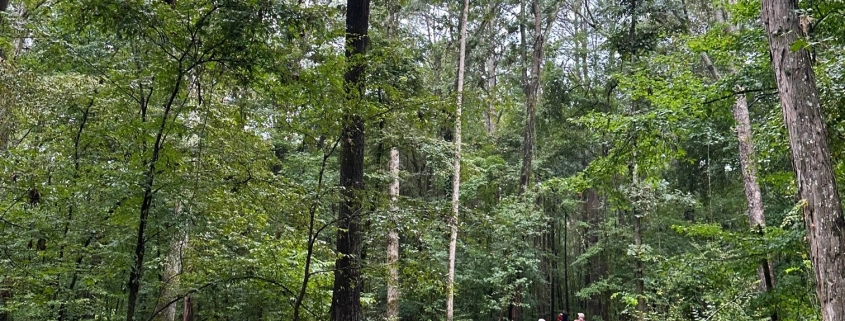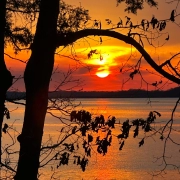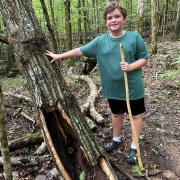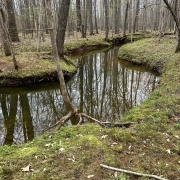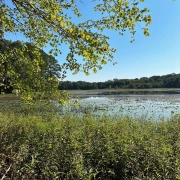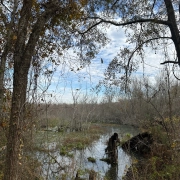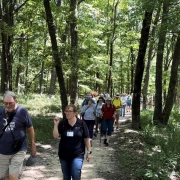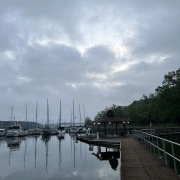Mid-September Wildflowers, Mushrooms, and Trees along the New Hiking and Biking Trail at Wheeler NWR!
On September 16, 2023, I co-led an OLLI (Osher Lifelong Learning Institute at the University of Alabama in Huntsville) Nature interpretive saunter on the Hiking and Biking Trail at the Wheeler National Wildlife Refuge near Decatur, Alabama. Although the dual-stemmed yellow poplar tree beyond the sign is sporting a few yellow leaves, I view mid-September here in northern Alabama as late summer. The average daily high for September 16 in nearby Huntsville is 86.6 degrees. The official high in Huntsville for the cloudy and damp day we walked reached just 79 degrees.
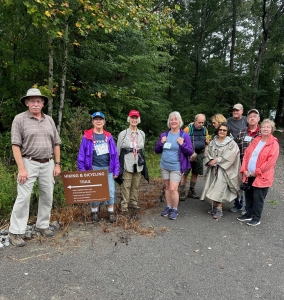
Summer Wildflowers
It’s only fitting that we encountered diverse summer wildflowers, including these particularly showy common evening-primrose.
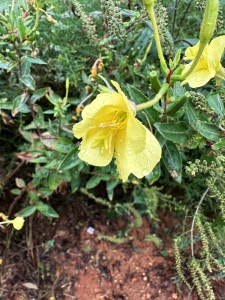
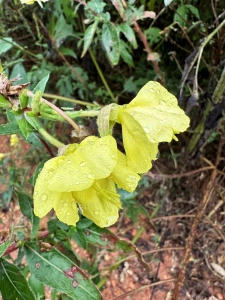
Giant ragweed towered above us in the more open areas. Its flowers, drab and unattractive, did not compete visually for our attention.
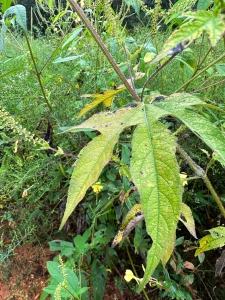
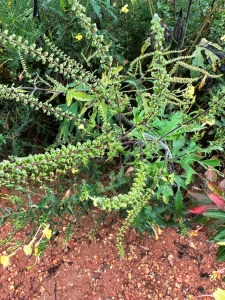
Bearded beggarticks (left) and late boneset added their beauty trailside.
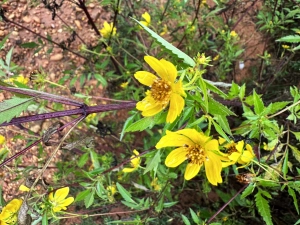
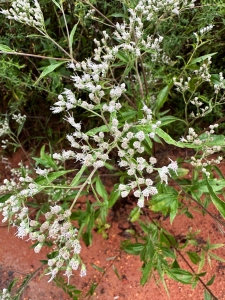
We found rough cocklebur in flower, already showing its bristly seed pods. We’ve all experienced having the velcroed pods hitching a ride on our pants as we’ve brushed against its ripe pods a few weeks deeper into the fall. I could think of nothing negative about the downy lobelia with its glossy leaves and complex light blue flowers.
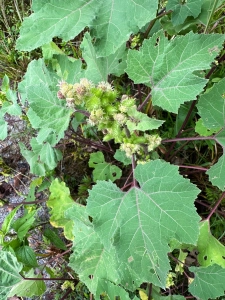
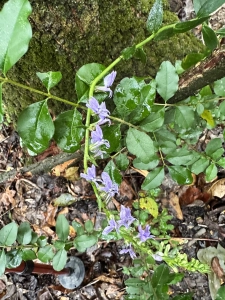
We strolled past dozens of other late summer bloomers, each one meriting inclusion in this post, but I had to draw the line somewhere. Perhaps on another day, my criteria may have yielded a far different portfolio.
Forests and Trees
This new trail at the Refuge passes through diverse habitats. The wildflowers prefer areas blessed (or cursed, depending on the trekker’s mood and the sun’s intensity) with sunlight reaching the ground with no more than partial forest shade. The trail below enters the full shade of an 80-year-old stand of mixed hardwoods. This riparian forest regenerated naturally on agricultural land abandoned when the TVA and Corps of Engineers acquired the Lake Wheeler impounded acreage and adjacent buffer land,
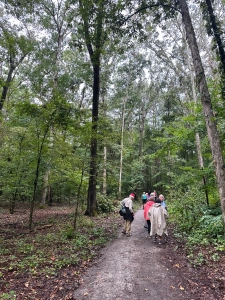
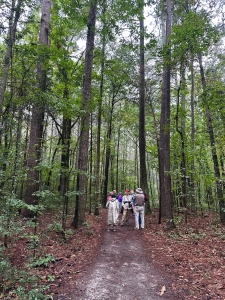
I record this 0:33 video as our OLLI entourage sauntered through the hardwood forest:
These are moist and fertile lands supporting a rich mix of hardwood species (left), and a handsome loblolly pine (right).
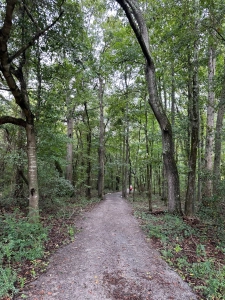
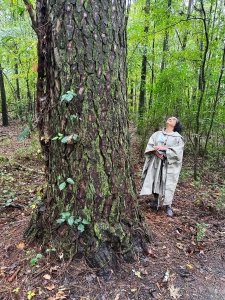
Along a forest edge fronting Cooperative Farm acreage, this slippery elm sapling reached long branches into the full sunlight. Direct sunlight is a precious resource, fueling this forest edge species in its quest to produce seed to ensure a next generation. Ulmus rubra is a medium sized deciduous tree common from southern Ontario south through central Alabama, with occasional individuals into northern Florida.
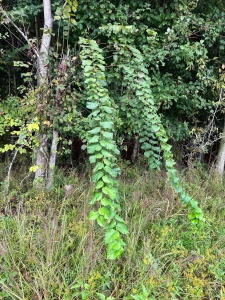
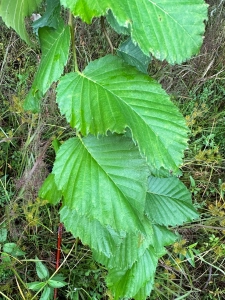
Cooperative Farms on the Refuge cover 4,000 acres, where farmers manage production, contractually agreeing to leave 15-18 percent of the grain crops for wildlife. This field, already harvested, grew corn. The trail is compacted, finely crushed limestone.
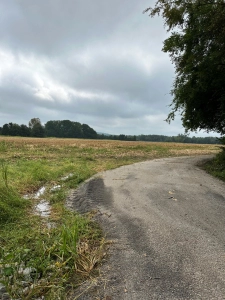
From open meadows lush with late summer wildflowers to deep riparian forests to agricultural crops, the trail transits diverse habitats assuring trekkers a rich portfolio of natural treats.
Fungi Kingdom
The maturing riparian forest we traversed is not static. Well into its ninth decade, the forest is producing tons per acre of dead and down woody debris. Blowdown and standing mortality occur routinely as stands age and surviving individual trees continue to grow ever-larger crowns. Eighty years ago a stand that carried thousands of sapling stems per acre now has fewer than dozens of 90-110-foot tall mature trees per acre. Growth and maturation and death occur naturally and predictably. Trees, branches, and woody debris are temporary features of the forest floor. Our long growing seasons, ample annual rainfall, and moist conditions encourage decay organisms, principally fungi.
We found false turkey tail (Stereum) ubiquitous on large downed woody debris.
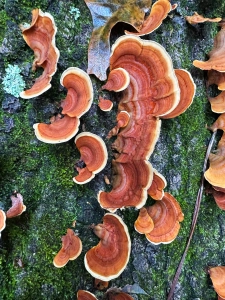
Far less common, jelly tree ear mushrooms drew my attention. I am a dedicated edible mushroom forager. This is one of my preferred edibles when I am in areas where collection is permitted, unlike along this public trail.
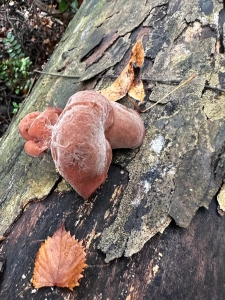
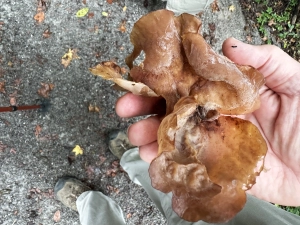
We also encountered several clusters of ringless honey mushrooms, which I could identify for our OLLI hikers.
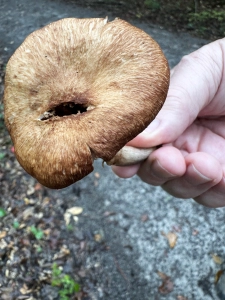
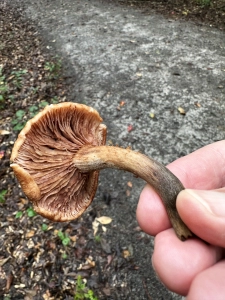
This large cluster of ringless honey mushrooms beckoned me, yet I left it undisturbed! Our purpose was Nature discovery, education, and interpretation…not foraging!
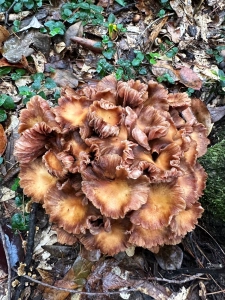
Not an edible, crowded parchment handsomely adorned smaller dead branches.

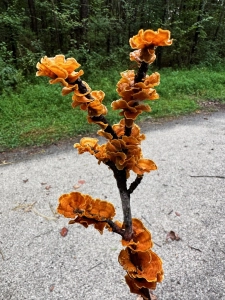
We also discovered a log decorated with dog vomit slime mold, a mercifully non edible mushroom with a demonstrably non-appetizing moniker!
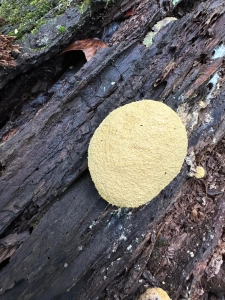
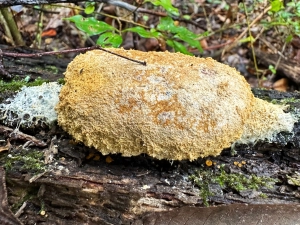
I thoroughly enjoy trekking with my OLLI colleagues, who generally share my demographic — retired professionals who are eager to learn and experience more about Nature. My retirement mission fits remarkably well with teaching in this population of lifelong learners:
Steve’s Mission: Employ writing and speaking to educate, inspire, and enable readers and listeners to understand, appreciate, and enjoy Nature… and accept and practice Earth Stewardship.
Thoughts and Reflections
I offer these observations:
- Nothing in Nature is static.
- All of us hunger to learn more about Nature.
- I am grateful to live within 15 miles of a national natural treasure: Wheeler National Wildlife Refuge!
Inhale and absorb Nature’s elixir. May Nature Inspire, Inform, and Reward you!
Note: Unless otherwise noted, all blog post images are created & photographed by Stephen B. Jones. Please circulate images with photo credit: “©2023 Steve Jones, Great Blue Heron LLC. All Rights Reserved.”
Another Note: If you came to this post via a Facebook posting or by another route, please sign up now (no cost… no obligation) to receive my Blog Post email alerts: http://eepurl.com/cKLJdL
And Third: I am available for Nature-Inspired Speaking, Writing, and Consulting — contact me at steve.jones.0524@gmail.com
A reminder of my Personal and Professional Purpose, Passion, and Cause
If only more of us viewed our precious environment through the filters I employ. If only my mission and vision could be multiplied by untold orders of magnitude:
Mission: Employ writing and speaking to educate, inspire, and enable readers and listeners to understand, appreciate, and enjoy Nature… and accept and practice Earth Stewardship.
Vision:
- People of all ages will pay greater attention to and engage more regularly with Nature… and will accept and practice informed and responsible Earth Stewardship.
- They will see their relationship to our natural world with new eyes… and understand their Earth home more clearly.
Tagline/Motto: Steve (Great Blue Heron) encourages and seeks a better tomorrow through Nature-Inspired Living!
Steve’s Three Books
I wrote my books Nature Based Leadership (2016), Nature-Inspired Learning and Leading (2017), and Weaned Seals and Snowy Summits: Stories of Passion for Place and Everyday Nature (2019; co-authored with Dr. Jennifer Wilhoit) to encourage all citizens to recognize and appreciate that every lesson for living, learning, serving, and leading is either written indelibly in or is powerfully inspired by Nature.
I began writing books and Posts for several reasons:
- I love hiking and exploring Nature
- I see images I want to (and do) capture with my trusty iPhone camera
- I enjoy explaining those images — an educator at heart
- I don’t play golf!
- I do love writing — it’s the hobby I never needed when my career consumed me
- Judy suggested my writing is in large measure my legacy to our two kids, our five grandkids, and all the unborn generations beyond
- And finally, perhaps my books and Blogs could reach beyond family and touch a few other lives… sow some seeds for the future

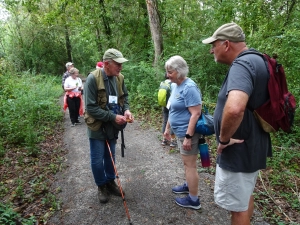
All three of my books (Nature Based Leadership; Nature-Inspired Learning and Leading; Weaned Seals and Snowy Summits) present compilations of personal experiences expressing my (and co-author Dr. Wilhoit for Weaned Seals and Snowy Summits) deep passion for Nature. All three books offer observations and reflections on my relationship with the natural world… and the broader implications for society. Order any from your local indie bookstore, or find them on IndieBound or other online sources such as Amazon and LifeRich.
I now have a fourth book, published by Dutton Land and Cattle Company, Dutton Land & Cattle: A Land Legacy Story. Available for purchase directly from me. Watch for details in a future Post.

